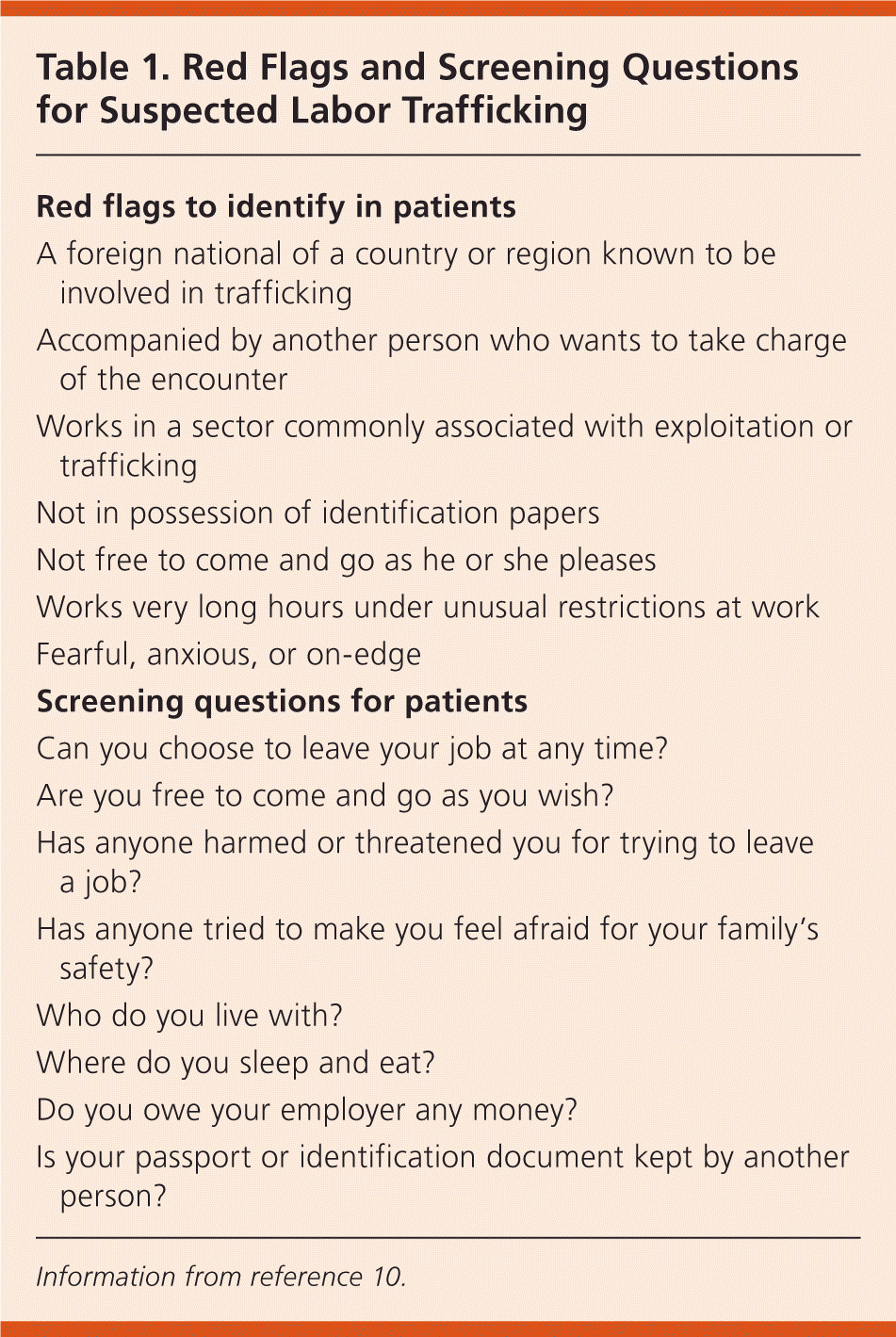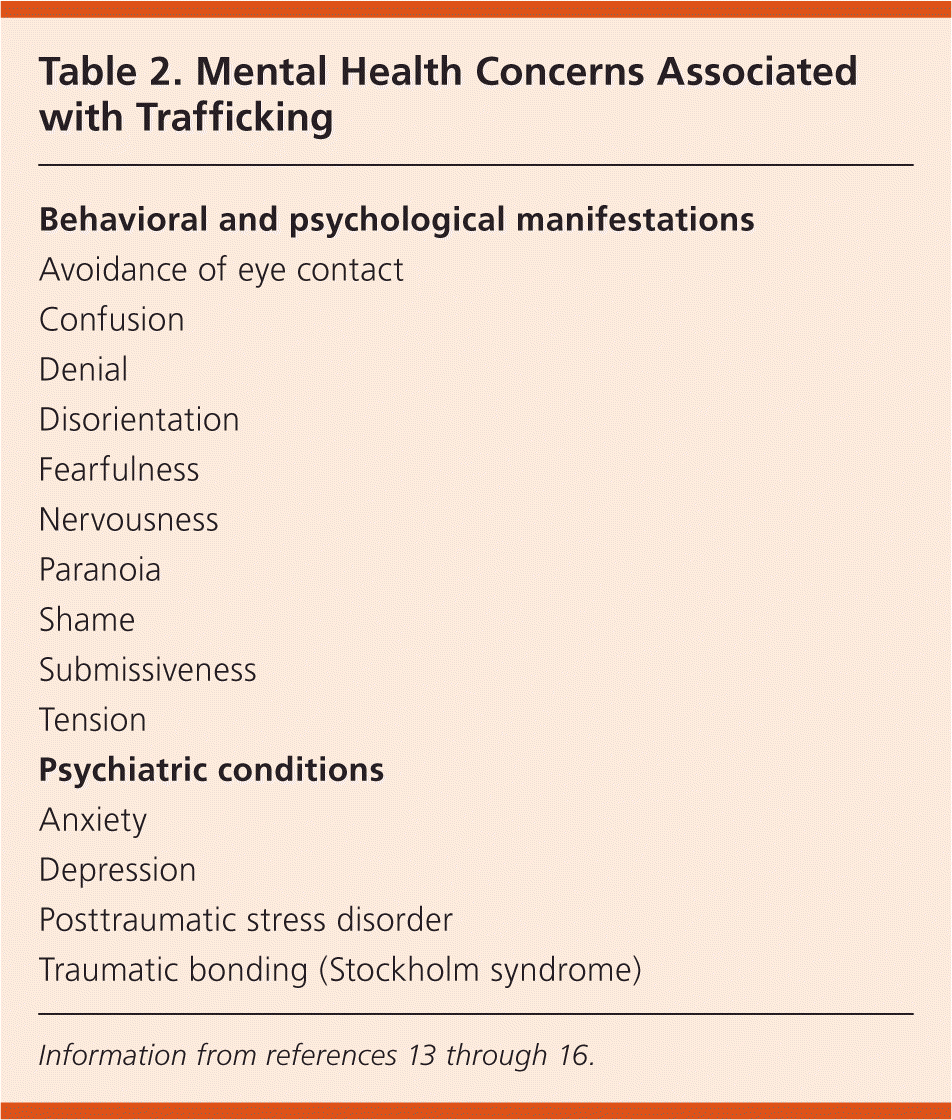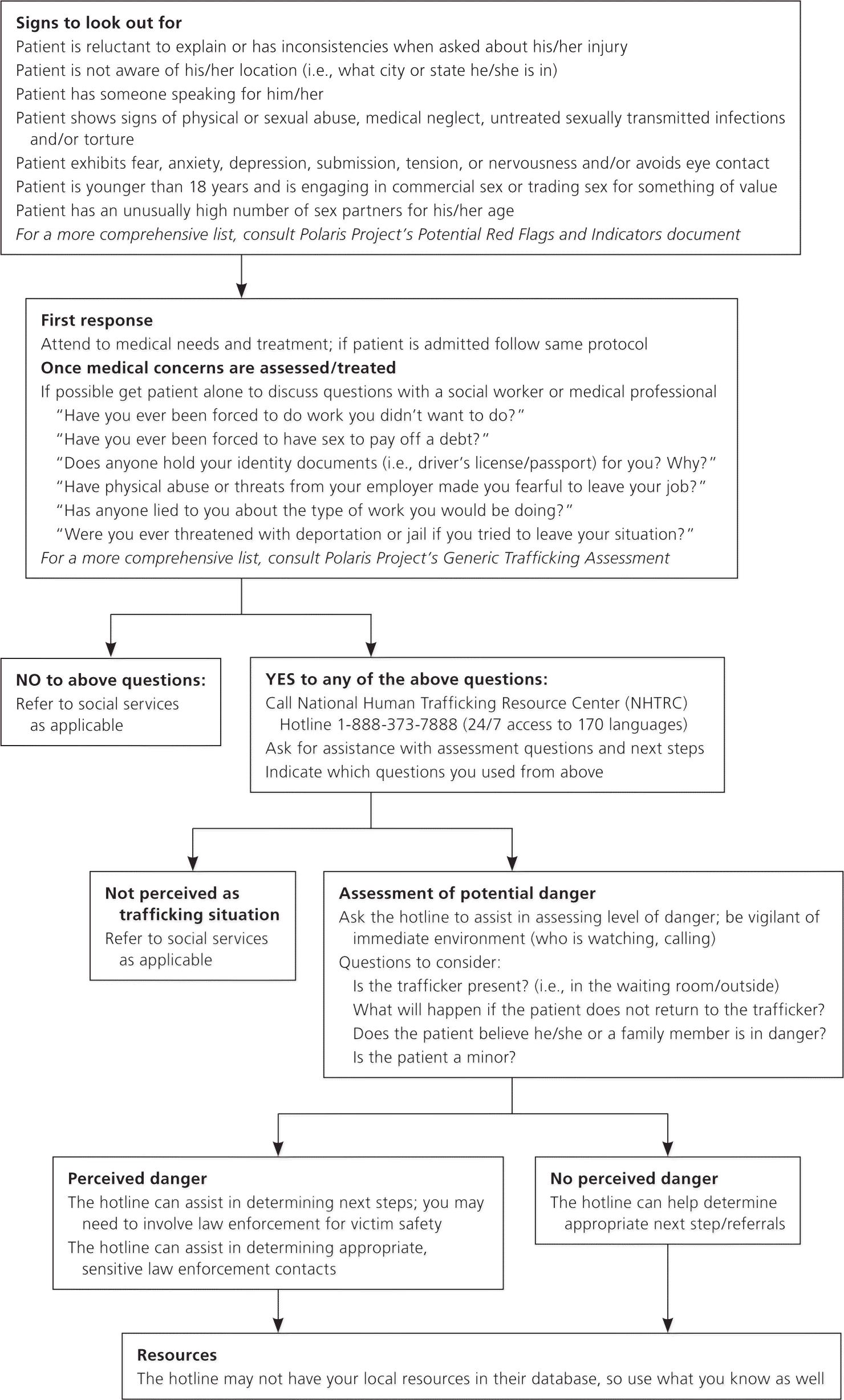
Am Fam Physician. 2015;92(12):1092-1095
Author disclosure: No relevant financial affiliations.
Case Scenario
A 39-year-old woman came to our clinic reporting headaches and bilateral knee pain. The patient was originally from Sri Lanka. She had no health insurance and was accompanied by another woman who seemed to be unrelated and of a different ethnic and socioeconomic status. The other woman insisted on remaining in the examination room with the patient and on responding to my questions, even though the patient was able to understand and speak English. The patient appeared submissive and had a flat affect and downcast eyes throughout the encounter. We suspected the patient was being exploited, perhaps as a result of human trafficking. What can physicians do if we suspect a patient is a victim of human trafficking?
Commentary
Several clues in this scenario suggest that the patient is indeed involved in trafficking. Although sex trafficking has received more media attention, labor trafficking—a form of slavery involving the illegal trade of persons for exploitation or commercial gain—is a big business, generating $150 billion annually.1 Labor trafficking involves the recruitment, harboring, transportation, provision, or obtaining of a person for labor or services through the use of force, threats, violence, fraud, debt bondage, or other forms of coercion.2 Globally, the International Labour Organization estimates that 21 million persons are entrapped in occupations that they are unable to leave.1
An estimated 18,000 persons are trafficked into the United States for labor each year.3 They most commonly originate from Latin America (31%), Southeast Asia (26%), and South Asia (13%), and 71% of persons enter on lawful visas.4 Domestic labor trafficking involves a variety of sectors and industries, including domestic servitude, agriculture, construction, elder care, hospitality, restaurant and food services, janitorial and cleaning services, manufacturing, door-to-door sales, and beauty services.5,6
IDENTIFICATION
Persons who are trafficked for labor include adults, minors, men, women, foreign nationals, and U.S. citizens; they may be challenging to identify, and there is a dearth of validated screening tools.9
Clinicians should note common red flags for trafficking (Table 1).10 These include patients who exhibit a lack of control over their own identification documents or money, or who may have a lack of knowledge about the city they are in or the address where they are staying.3,11,12 Because administrative staff can elucidate whether patients have access to personal forms of identification or familiarity with their personal information, they can alert physicians to patients who appear to be impeded from sharing details about themselves.

| Red flags to identify in patients |
| A foreign national of a country or region known to be involved in trafficking |
| Accompanied by another person who wants to take charge of the encounter |
| Works in a sector commonly associated with exploitation or trafficking |
| Not in possession of identification papers |
| Not free to come and go as he or she pleases |
| Works very long hours under unusual restrictions at work |
| Fearful, anxious, or on-edge |
| Screening questions for patients |
| Can you choose to leave your job at any time? |
| Are you free to come and go as you wish? |
| Has anyone harmed or threatened you for trying to leave a job? |
| Has anyone tried to make you feel afraid for your family's safety? |
| Who do you live with? |
| Where do you sleep and eat? |
| Do you owe your employer any money? |
| Is your passport or identification document kept by another person? |
HEALTH IMPACT OF LABOR TRAFFICKING
Physical Health. Labor trafficking victims may experience a multitude of occupational exposures resulting in health issues that prompt them to seek care. Environmental risks may include dangerous heights, confined spaces, dangerous machinery, loud noises, hazardous temperatures, pesticides, and chemical processes.13,14 These may occur over long hours of exposure and in isolation or confinement by an employer.
Consequently, physical symptoms associated with trafficking may be specific to the form of forced labor that a patient has experienced. For persons in domestic servitude, for example, issues can include chronic back pain, joint pain, bruising, and headaches. Other physical signs and symptoms that may be related to occupational exposure include noise-induced hearing loss, visual disturbances, and respiratory difficulties, depending on work conditions and chronicity of exposure.14 The physical examination may also reveal amputations from machine-related injuries, scars from abuse, and evidence of malnourishment. Children involved in trafficking may have poorly formed or rotting teeth and stunted growth.15
Mental Health. The impact of trafficking on a person's mental health can manifest as a behavioral or a psychiatric condition (Table 2).13–16 Traffickers and employers can exert control through psychological manipulation, often directly affecting the patient's mental health. Because factors that increase vulnerability to labor trafficking include immigration status, isolation, and debt, traffickers capitalize on persons who have limited economic opportunities. They may then leverage a person's undocumented status or large debts to blackmail or threaten him or her into compliance. They may also coach these patients to fabricate stories that are less likely to arouse suspicion when questioned, and arrange for persons being trafficked to be monitored or escorted during their activities.

| Behavioral and psychological manifestations |
| Avoidance of eye contact |
| Confusion |
| Denial |
| Disorientation |
| Fearfulness |
| Nervousness |
| Paranoia |
| Shame |
| Submissiveness |
| Tension |
| Psychiatric conditions |
| Anxiety |
| Depression |
| Posttraumatic stress disorder |
| Traumatic bonding (Stockholm syndrome) |
MANAGEMENT
Approaches to caring for survivors of interpersonal and domestic violence can be applied in the care of victims of human trafficking. Physicians should make all efforts to conduct a portion of the encounter with the patient alone. Ways to enable private visits include notifying accompanying persons that one-on-one interviews are standard clinic procedure, and proactively placing signs in the office that state, “Patients only beyond this point.”17 In addition, physicians should arrange for one or more follow-up visits to build rapport and explore the patient's options for leaving an exploitative situation.

TRAFFICKING RESOURCES AND REPORTING
In cases of suspected trafficking, physicians can contact law enforcement by telephone, or submit a tip online using information provided on the Department of Homeland Security's Blue Campaign website at https://www.dhs.gov/blue-campaign/identify-victim.
Physicians can also find local community-based resources compiled by the Polaris Project (http://www.PolarisProject.org) to assist these patients. The referral initiative 2-1-1 (http://211.org/services/human-trafficking) is another nationwide resource to report trafficking and to help patients gain access to services.
Given the prevalence of human trafficking, family physicians may encounter patients who are actively experiencing or have previously experienced exploitation. Appropriate identification and treatment of these patients requires sensitive, collaborative, and practice-wide efforts to optimally serve them.
